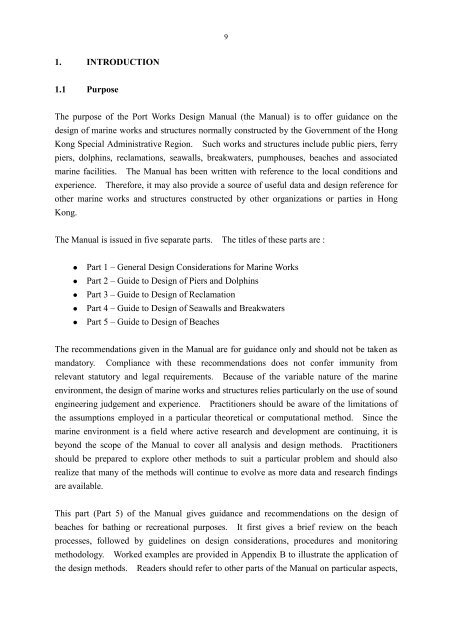PORT WORKS DESIGN MANUAL PART 5 Guide to Design of ...
PORT WORKS DESIGN MANUAL PART 5 Guide to Design of ...
PORT WORKS DESIGN MANUAL PART 5 Guide to Design of ...
Create successful ePaper yourself
Turn your PDF publications into a flip-book with our unique Google optimized e-Paper software.
9<br />
1. INTRODUCTION<br />
1.1 Purpose<br />
The purpose <strong>of</strong> the Port Works <strong>Design</strong> Manual (the Manual) is <strong>to</strong> <strong>of</strong>fer guidance on the<br />
design <strong>of</strong> marine works and structures normally constructed by the Government <strong>of</strong> the Hong<br />
Kong Special Administrative Region. Such works and structures include public piers, ferry<br />
piers, dolphins, reclamations, seawalls, breakwaters, pumphouses, beaches and associated<br />
marine facilities. The Manual has been written with reference <strong>to</strong> the local conditions and<br />
experience. Therefore, it may also provide a source <strong>of</strong> useful data and design reference for<br />
other marine works and structures constructed by other organizations or parties in Hong<br />
Kong.<br />
The Manual is issued in five separate parts. The titles <strong>of</strong> these parts are :<br />
• Part 1 – General <strong>Design</strong> Considerations for Marine Works<br />
• Part 2 – <strong>Guide</strong> <strong>to</strong> <strong>Design</strong> <strong>of</strong> Piers and Dolphins<br />
• Part 3 – <strong>Guide</strong> <strong>to</strong> <strong>Design</strong> <strong>of</strong> Reclamation<br />
• Part 4 – <strong>Guide</strong> <strong>to</strong> <strong>Design</strong> <strong>of</strong> Seawalls and Breakwaters<br />
• Part 5 – <strong>Guide</strong> <strong>to</strong> <strong>Design</strong> <strong>of</strong> Beaches<br />
The recommendations given in the Manual are for guidance only and should not be taken as<br />
manda<strong>to</strong>ry. Compliance with these recommendations does not confer immunity from<br />
relevant statu<strong>to</strong>ry and legal requirements. Because <strong>of</strong> the variable nature <strong>of</strong> the marine<br />
environment, the design <strong>of</strong> marine works and structures relies particularly on the use <strong>of</strong> sound<br />
engineering judgement and experience. Practitioners should be aware <strong>of</strong> the limitations <strong>of</strong><br />
the assumptions employed in a particular theoretical or computational method. Since the<br />
marine environment is a field where active research and development are continuing, it is<br />
beyond the scope <strong>of</strong> the Manual <strong>to</strong> cover all analysis and design methods. Practitioners<br />
should be prepared <strong>to</strong> explore other methods <strong>to</strong> suit a particular problem and should also<br />
realize that many <strong>of</strong> the methods will continue <strong>to</strong> evolve as more data and research findings<br />
are available.<br />
This part (Part 5) <strong>of</strong> the Manual gives guidance and recommendations on the design <strong>of</strong><br />
beaches for bathing or recreational purposes. It first gives a brief review on the beach<br />
processes, followed by guidelines on design considerations, procedures and moni<strong>to</strong>ring<br />
methodology. Worked examples are provided in Appendix B <strong>to</strong> illustrate the application <strong>of</strong><br />
the design methods. Readers should refer <strong>to</strong> other parts <strong>of</strong> the Manual on particular aspects,

















